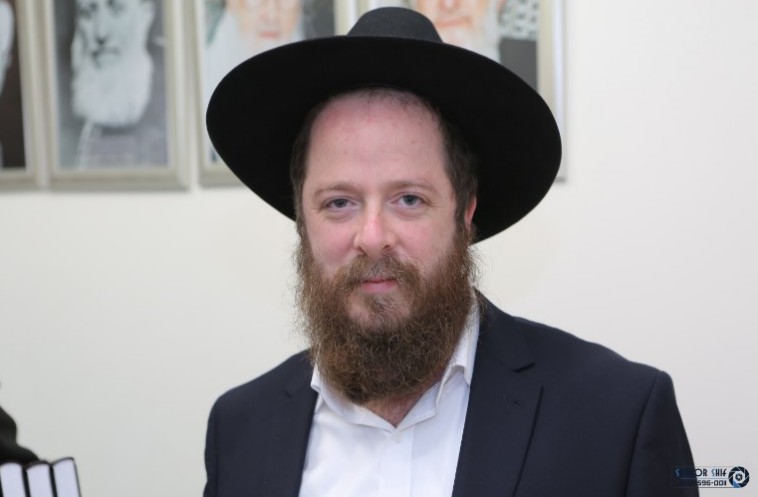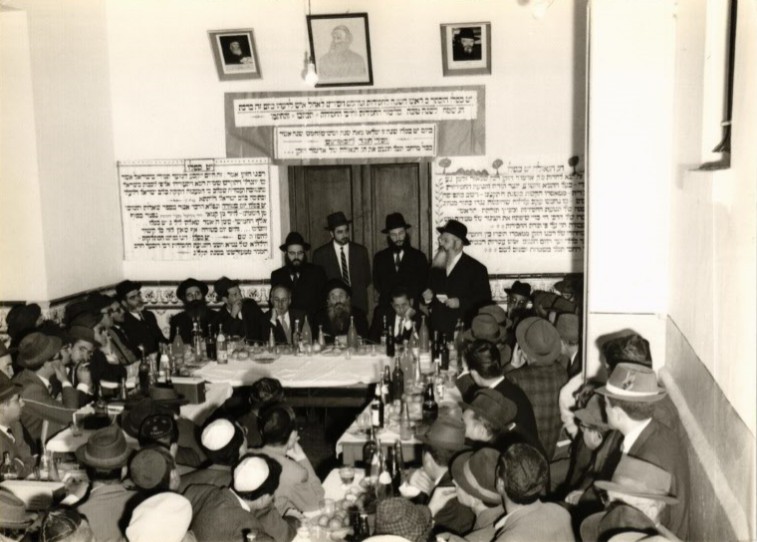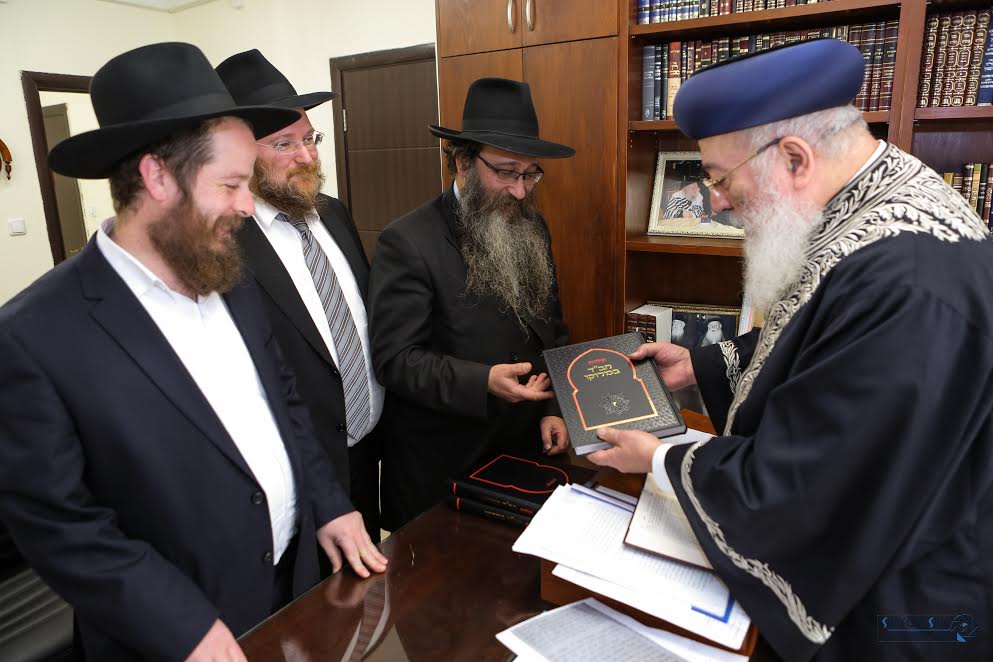The Secret and Wonderful Connection Between Chabad Hasidism and Moroccan Jewry
A surprising message received by Chabad historian Rabbi Shneor-Zalman Berger led to a captivating book detailing the story of the Lubavitcher Rebbe's emissaries and Moroccan Jews, whose destinies became intertwined. The book provides a glimpse into intriguing historical events, such as the struggles for Torah-based education in Morocco, and Baba Sali's enthusiasm for aiding the emissaries.
 With Rabbi Amar
With Rabbi AmarOne of the fascinating aspects of the Jewish world is the surprising and intriguing connections that naturally occur within it, inspiring admiration. One such connection is the strong, positive, and surprising relationship that developed in the last century between Chabad Hasidism and Moroccan Jewry in its various branches. A few years after assuming leadership of the Chabad movement, the Lubavitcher Rebbe instructed his followers to reach every Jewish point worldwide, ensuring that no Jew—elderly, adult, or child—is left without the opportunity to live a Jewish life according to the Torah, in comfort, joy, and with a good heart.
One of the main targets the Rebbe focused on was Morocco. The large Jewish population there fueled his imagination, and he asked several followers to travel to the distant country to work to improve both the spiritual and physical lives of the locals.
Rabbi Shneor Zalman Berger (41), a Chabad historian, has published numerous articles, biographies, and historical books, including a biographical-research book on Rabbi Chaim Naeh, known as 'Ba'al HaShiurim,' related to the descendants of the late Rabbi Shlomo Matusof, a former director of Chabad institutions in Morocco. A surprising inquiry led Rabbi Berger to delve deeply into the subject, resulting in a book that encapsulates the main aspects of this unique connection between Chabad and Moroccan Jewry.
 Rabbi Shneor Zalman Berger
Rabbi Shneor Zalman Berger"I was offered to edit a book documenting the Lubavitcher Rebbe's activities in Morocco from 1950 onwards," recounts Rabbi Berger. "After drafting a reliable and document-based narrative in fluent language, I embarked on the project. Shortly after, I received the Chabad archives in Morocco, comprising numerous files containing correspondences with the Rebbe, Moroccan rabbis, and the emissaries. After a three-year process, a full-color album-format book of 430 pages was published, detailing the Chabad kingdom in Morocco."
What surprising and interesting things did you discover while working on the book?
"The truth is that from prior readings and different stories, I already knew quite a bit about Chabad in Morocco. Despite that, I was utterly amazed to see the incredible and unimaginable scope of activities. Guided by the Rebbe, the emissaries established a variety of institutions in seventy cities, towns, and villages across Morocco within a few short years of their arrival. As a result, thousands of Jewish children studied Torah at a high level, with the emissaries organizing and founding the institutions. Yet, in most places, the managers and teachers were local Jews who received funding, oversight, and guidance from the Rebbe's emissaries."
 Book cover
Book coverWas there Chabad activity in other African countries?
"Rabbi Nissen Pinson, of blessed memory, one of the first emissaries in Morocco, worked in the country for several years. He then moved to Tunisia at the Rebbe's instruction, where he worked for decades. In South Africa and other African countries, there is still extensive Chabad activity, but it differs in nature from the mission in North Africa."
From your knowledge, how did the Moroccan rabbis relate to the Chabad emissaries and rabbis?
"The reception was truly amazing. In large cities and remote villages alike, the rabbis welcomed the Rebbe's emissaries with open arms. There are many examples, thank Hashem, such as Rabbi Raphael Baruch Toledano, the rabbi of Meknes, who strongly supported the Chabad emissary, Rabbi Michael Lipsker. Or Rabbi Shalom Mashash, the chief rabbi of Casablanca, who was at the forefront of everything related to Chabad institutions in Morocco, working hand in hand with emissaries Rabbi Shlomo Matusof, Rabbi Nissen Pinson, Rabbi Leib Raskin, and Rabbi Shalom Edelman. When Rabbi Matusof arrived in Erfoud, the director of Chabad institutions in Morocco and approached the city's rabbi, none other than Rabbi Yisrael Abuchatzeira, known as Baba Sali, he was immediately welcomed, and they began establishing a Talmud Torah during that very visit."
"Kabbalah Study Has Always Been Part of Moroccan Tradition"
"What's even more amazing to see," continues Rabbi Berger, "is that the community members welcomed the Chabad Hasidim with no less warmth and joy than their rabbis did. Despite all the differences between them, it went very smoothly. I suppose it's also related to the fact that divine providence managed to introduce the emissaries to the Sephardic world before they arrived in Morocco. All the Rebbe's emissaries in Morocco did come from Russia, but during World War II, they fled the front and stayed in the cities of Bukhara—Tashkent and Samarkand—where they became slightly acquainted with Sephardic customs and culture.
"After Rabbi Shlomo Matusof left Russia and arrived in France, he worked, under the instructions of the Chabad Rebbes, with Jews from North Africa who were staying in transit camps on their way to Israel. Even so, it's clear there are different cultures and customs here, but the Rebbe insisted that the emissaries consider the customs and culture. Thus, for instance, in Chabad celebrations, candles were lit in honor of the righteous, and there were villages where students learned while sitting on carpets and wearing jellabas, which was certainly not typical among Chabad Hasidim.

"Nevertheless, it can be noted that the study of Hasidism, of course, was a new world for Moroccan Jews. But the Rebbe repeatedly clarified to the emissaries and Moroccan rabbis that it wasn't completely new, as Kabbalah study had always been part of Moroccan tradition, and Hasidism is primarily an explanation and detail of the Kabbalistic teachings and the inner Torah. Indeed, over time, the study of Hasidism fit well within Chabad institutions in Morocco, and magnificent gatherings were held before each Hasidic festival, attended by rabbis, public figures, and a large audience."
Aside from Baba Sali, can you tell us about other rabbinic figures who were part of this unique connection?
"Rabbi Baruch Abuchatzeira, Rabbi David Abuchatzeira, Rabbi Elazar Abuchatzeira of blessed memory, who was murdered in Be'er Sheva, their sister, Rebbetzin Zohari, the wife of Rabbi Chaim Pinto, the rabbi of Ashdod and Kiryat Malachi, Chief Rabbi of Israel and Chief Rabbi of Jerusalem Rabbi Shlomo Moshe Amar, Rabbi Eliyahu Abergel, head of the rabbinical courts and rabbi of the Baka neighborhood in Jerusalem, Rabbi Moshe Ben Abu, the rabbi of the Gilo neighborhood, and many others."
Have you received feedback or criticism on the book from any of the mentioned rabbis?
"Chief Rabbi of Israel and Chief Rabbi of Jerusalem, Rabbi Shlomo Moshe Amar, studied in his youth at the Chabad yeshiva in Casablanca. He even wrote a special foreword for the book and received sections from the book before its printing. When the book was published, we presented it to him with the descendants of the emissaries in a lengthy meeting held at the Chief Rabbinate of Jerusalem. The rabbi was very impressed by how a rich historical archive was 'translated' into an accessible and readable book that detailed the Chabad empire in Morocco."
What do you think this says about the connection that should exist between the various communities in Israel? After all, an amazing integration between East and West was revealed here.
"The connection must indeed exist and be fully realized. The Lubavitcher Rebbe advocated for Jewish unity and love among all circles and communities, and it's well-known that various Jewish communities integrated among Chabad Hasidim. Moreover, enthusiasm for anything holy is a common trait between Chabad Hasidim and many Moroccan Jews, and I believe, in this case, it greatly helped this connection to occur."
They say that creating a book, from nothing, is somewhat like a birth. As known, writing a book brings with it intriguing events, and along with interesting and important stories about happenings in Morocco during those challenging years, some interesting things occurred around the book's creation, which we would like to hear from Rabbi Berger. "Many people ask me if I traveled to Morocco for the sake of writing the book, but the truth is I did not. However, one of Baba Sali's descendants, who reviewed the book, enthusiastically said that he is sure that whoever wrote the book was born in Morocco and still lives there. I might add that the graphic artist, Boaz Sharon, visited Morocco in recent years and added a Moroccan flair to the book, or as Chief Rabbi Amar pointed out: 'The book is in Moroccan colors, and it's very important.'"
 With Rabbi Amar
With Rabbi AmarWho collaborated with you on writing the book and completing it?
"First and foremost, the Rebbe's emissaries to Morocco who are alive today—the late Rabbi Shalom and Rebbetzin Gitl Edelman, and Rebbetzin Raizel Raskin, currently on a mission in Casablanca, as well as Rabbi Azriel Chaikin, who served on a mission in Agadir, and his father-in-law Rabbi Michael Lipsker, who was on a mission in Meknes. The descendants of the emissaries and graduates of the institutions assisted me throughout with information and wise advice, and the person leading the book's publication was Rabbi Reuven Matusof, the Rebbe's emissary at the Paris Lubavitch office. The people behind the book are the Matusof family, whose father managed Chabad institutions in Morocco on the Rebbe's mission. Their goal is to publicize the successful mission that yielded fruitful outcomes scattered worldwide."
"Morocco Was the First Country the Rebbe Sent Emissaries To"
An actual struggle took place between Chabad and the Joint Distribution Committee during the early years of Chabad institution establishment in Morocco, according to Rabbi Berger. The Rebbe firmly insisted that they reach every Jewish child in every remote village, even if the studies were under non-modern conditions, and even if, in some places, students of different ages would learn in one classroom without a notebook or pencil. In contrast, the Joint Distribution Committee had a different view, threatening that if Chabad continued to expand institutions in every village, especially when they did not resemble Western schools, they would cease all funding. Finally, a special delegation from the Joint Distribution Committee headquarters in the United States was sent to Morocco, including Rabbi Eliyahu Jung, an Orthodox rabbi who greatly assisted institutions worldwide in his official capacity.
"When Rabbi Jung arrived in Morocco, he understood the complex issues and decided to appoint an Orthodox Jewish representative of the Joint Distribution Committee in Morocco who would find common ground with the emissaries," says Rabbi Berger. "Shortly thereafter, Rabbi Yisrael Schiff arrived, and issues were resolved. Since then, for decades, seventy percent of the institution's expenditures have been funded monthly, allowing thousands of students, from Casablanca to remote villages, to continue studying Torah and tasting Hasidic teachings."

Toward the end of our conversation, Rabbi Berger reflects on the conclusions he will carry from the rigorous work he devoted to this topic. "The process of spreading Judaic and Hasidic teachings in Morocco involved journeys along winding roads, sometimes even on donkeys, all to reach remote villages in the Sahara. When one meets students from Erfoud today, located 600 kilometers from Casablanca, they understand the righteous spirit of the Rebbe, who clung to the goal and instructed at all costs to reach every child in Morocco and assist them in entering beneath the wings of the Divine Presence—to study Torah and observe the commandments."
What are your plans for the book you published?
"We want to put 'Your springs shall spread outward' into action—disseminate it widely in the Holy Land and across the globe. The book was launched for the Chabad emissaries' convention at the end of the month of Cheshvan, as Morocco was the first country where the Rebbe sent emissaries, and hundreds of copies were sold in New York at the convention."

